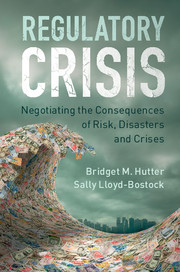Book contents
- Regulatory Crisis
- Regulatory Crisis
- Copyright page
- Dedication
- Contents
- Tables
- Preface
- Acknowledgements
- Abbreviations
- 1 Risk Regulation and High-Profile Disasters
- 2 Regulatory Environments Preceding the Crisis
- 3 Recognizing Disasters and Crises
- 4 The Many Shapes of Regulatory Crisis
- 5 Official Sense-Making
- 6 Responses to Inquiry Findings
- 7 Regulatory Crises
- References
- Index
- References
References
Published online by Cambridge University Press: 04 July 2017
- Regulatory Crisis
- Regulatory Crisis
- Copyright page
- Dedication
- Contents
- Tables
- Preface
- Acknowledgements
- Abbreviations
- 1 Risk Regulation and High-Profile Disasters
- 2 Regulatory Environments Preceding the Crisis
- 3 Recognizing Disasters and Crises
- 4 The Many Shapes of Regulatory Crisis
- 5 Official Sense-Making
- 6 Responses to Inquiry Findings
- 7 Regulatory Crises
- References
- Index
- References
- Type
- Chapter
- Information
- Regulatory CrisisNegotiating the Consequences of Risk, Disasters and Crises, pp. 234 - 255Publisher: Cambridge University PressPrint publication year: 2017

